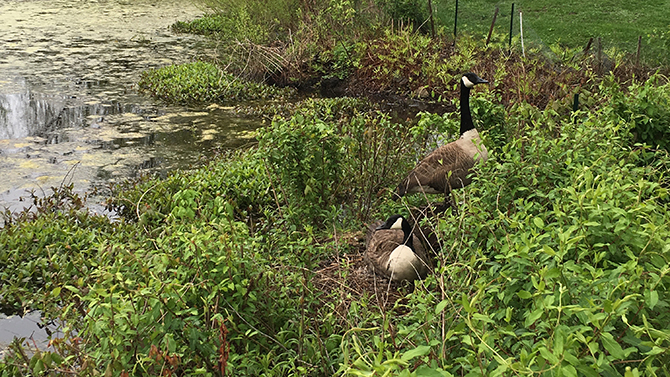


Canada geese
October 03, 2016
UD study looks at population fluctuations of Canada geese in New Jersey
When populations of Canada geese and other species of waterfowl were on the decline in the Mid-Atlantic in the early part of the 20th century, conservationists made it a priority to save the species by protecting habitat, setting hunting restrictions, and translocating geese to the region.
They were wildly successful and not only did the Canada geese populations explode in the Mid-Atlantic, some of those geese decided to take up permanent residence in the region.
A recent study led by the University of Delaware set out to understand exactly how much the resident Canada geese population has grown in recent years as well as looking specifically at how habitat has changed to influence hatchability and nest success.
The studies were led by Chris Williams, professor of wildlife ecology who also oversees a waterfowl and upland gamebird research program in UD’s College of Agriculture and Natural Resources; Kate Guerena, who received a master’s degree from UD in 2012 who now works for the United States Fish and Wildlife Service; and Julie Beston, a post-doctoral researcher who now works as an assistant professor at the University of Wisconsin-Stout.
Their recent papers were published in the Journal of Wildlife Management and the Wildlife Society Bulletin.
Changing evolutionary drive
In the 1930s and ’40s, wildlife biologists started to bring Canada geese from other parts of the country to try to supplement the population. As lawns started to proliferate and hunting regulations were extremely restrictive, many of these resident geese flocks began to thrive and expand their range.
For a segment of the Canada goose population, they changed their evolutionary drive in that they were once a migratory species that would winter in the Mid-Atlantic and then fly north to breed in Canada.
While another segment of the population has retained its migratory behavior, it is these resident birds that have so drastically increased in population size and cause a nuisance year round for home owners and motorists.
“It took decades to build up the behaviorally and evolutionary distinct subpopulation but little by little, you had increasing numbers of young being born that learned from their parents to stay year round in the place of their birth,” said Williams.
Creating suburban habitat
Perhaps the biggest factor for the population increase in resident Canada geese is that they have been able to take advantage of the increasing reaches of suburbia and urbanization that have changed the landscape dramatically, especially in the last few decades.
“We are producing a whole new landscape, which some wildlife are able to take advantage of while others can’t,” Williams said. “We have an increasing urban wildlife problem, whether it’s white-tailed deer, Canada geese, or just raccoons in the back yard. Animals that are learning how to adapt themselves to a fragmented suburban environment can be successful.”
This is a problem across the region but it is especially true in New Jersey, which is the most densely populated state in the United States and has seen quick changes in land use.
The advantage for Canada geese in a suburbanized or urban environment is that those environments create a lot of nesting habitat for the species.
“Whether its increased lawns around homes, office parks, or ponds, we are creating a perfect habitat where geese can lay a nest and have lots of preferred grass food for themselves and their chicks. Combine this with a lower predator base in these environments, it creates a recipe for goose population explosion,” said Williams.
If Canada geese can reach a truly urban environment, such as a traffic island in a shopping center parking lot, they likely won’t encounter any predators. “They’ll take advantage of that and other than humans, there’s no-one else bugging them,” said Williams.
The research has confirmed that these areas had the highest rate of nest survival.
New Jersey geese
Using data collected from 1985-89, 1995-97 and 2009-10, the researchers found that the population of resident snow geese in New Jersey has been readily increasing from 29,000 in the early 1990s to 106,000 in the early 2000s.
“That becomes a real problem because then you have increased car accidents [from geese walking across roads] and goose feces in the lawn. The end result is people start hating Canada geese,” said Williams.
In response, management measures were implemented to control the burgeoning population and by 2014 it was down to 77,000 geese.
Williams said that it is important to consider carrying capacity — the amount of wildlife that can be sustained on a landscape without environmental degradation — and social carrying capacity — the amount of wildlife that humans will put up with until the wildlife become a nuisance and causes harm — when thinking of control measures in an urban or suburban setting.
“The trick for managers is finding that balance. As we have an increasing suburban and urbanized world, we are creating more habitats that protect these resident Canada geese, giving them the resources and safety that they’re looking for. So what can we do to effectively reduce a segment of the population to reduce negative human-wildlife interactions?” said Williams.
Williams’ two new research papers help provide information for wildlife biologists in the east coast to better design management plans to help control the resident Canada geese and meet regional population goals.
Contact Us
Have a UDaily story idea?
Contact us at ocm@udel.edu
Members of the press
Contact us at 302-831-NEWS or visit the Media Relations website

